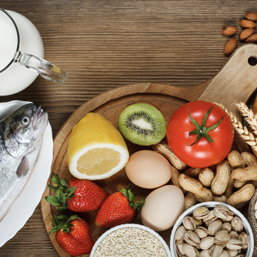
“I couldn’t live without ice cream and pizza!” a kid exclaimed to their friend as my daughter and I walked past. My child and I looked at each other with knowing glances and later she said, “Mommy, I don’t have ice cream or pizza.” She was right; pizza and ice cream contain milk, and she has a milk allergy.
I asked pediatric allergist Dr. Stephen Cheuk at YYC Allergy Clinic to give us the scoop on food allergies.
Q: There is so much misinformation out there about food allergies. What is a food allergy?
A: A food allergy is when your immune system sees a certain food protein as harmful and reacts by triggering an allergic reaction. Some food allergies can cause anaphylaxis, a life-threatening type of reaction. Even a very small crumb or drop of food can trigger anaphylaxis in someone with food allergies. However, reactions can vary even with the same food exposure and not every exposure causes anaphylaxis.
Q: What are the common food allergies you see in kids today?
A: The most common food allergies we saw when I was training as an allergist were milk, eggs, wheat, soy, peanuts, tree nuts, fish and shellfish. Some newer ones that we also see today are sesame seeds, mustard seeds and kiwi allergies. The profile of food allergies may be changing.
Q: What are some of the symptoms of a food allergy?
A: Food allergies most commonly will cause hives, rashes and swelling. Sometimes they affect the gastrointestinal system and cause vomiting and diarrhea. Less commonly one might see changes in breathing and distress, but this is pretty extreme.
That’s why doctors recommend slow introduction of new food items in infants so that parents can monitor in case anything unexpected starts to happen. Typically a smaller dose will give a smaller reaction, though this is not always the case.
Q: What is the current advice on introducing allergens to infants?
A: At this time (spring 2023), we recommend early introduction to allergenic foods. Parents and guardians should start slowly with introducing foods to babies and gradually increase the amount a child eats. Some physicians suggest introduction of allergenic foods at four months of age, but most aim for six months. The truth lies somewhere around that time frame but we don’t have exact data. The latest research supports early introduction of food allergens.
Remember, parents should carefully introduce non-choking forms of foods containing common allergens in small amounts and gradually increase the amount they offer depending on the age of the child. A tiny exposure to all common allergens on a consistent basis acts as a preventative strategy when it comes to food allergies.
Q: Do you have any advice for parents on how to prevent food allergies?
A: Early introduction and continued exposure on a regular basis to foods, especially before one year of age, seems to reduce the chance of developing food allergies. This will not stop all babies from developing food allergies, but it has been shown to substantially drop the rates of food allergies.
Once your baby has eaten a food and shown no signs of an allergic reaction, it’s very important to keep feeding that food to your baby. Eating common allergenic foods, even in small amounts for young children a few times each week helps to prevent the development of food allergy.
Q: Is there a cure for food allergies?
A: There is no cure yet for food allergies. We hope that with desensitization programs we are developing a cure. There hasn’t been enough time to collect data. We have some possible sustained tolerance and likely disappearance of allergy symptoms that have happened. We hope everyone gets there. There is a trend in that direction. It’s slower for some and faster for others.
Want to learn more about food allergies? Visit FoodAllergyCanada.ca to find resources on living with food allergies, support groups and more.
Krista is a freelance writer and homeschooling mom of two kids. She is a former librarian who loves to jump rope, drink tea and share books with family and friends.
See our related articles:
Calgary’s Child Magazine © 2024 Calgary’s Child